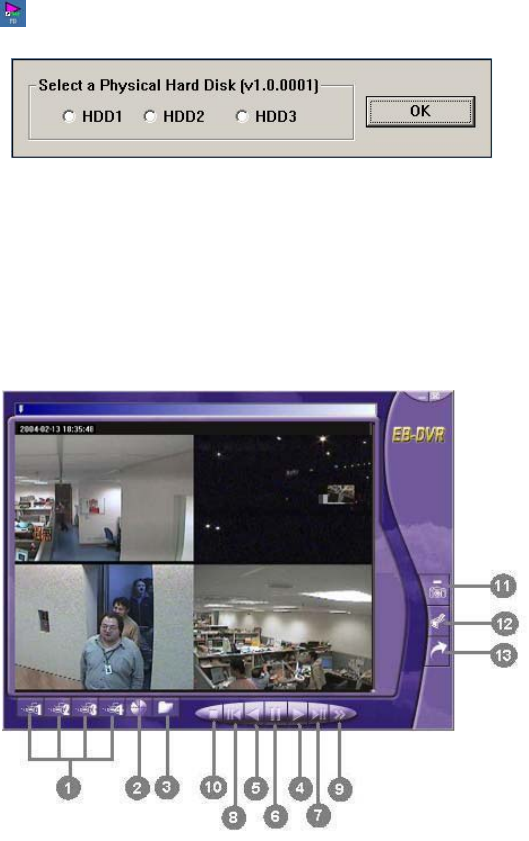
25
Operating EB-DVR Playback Application
Click to run the application. Select the Hard Disk and click OK.
You will see EB-DVR screen as followed.
1. Channel 1- Channel 4: Switch between cameras.
2. Change Driver: Switch between different hard disks.
3. Event List: Display all the recorded events stored in hard disks.
4. Play: Play the recorded video.
Note: The DVR’s HDD number will be next to your PC’s HDD
number. If there is only one hard disk in PC, PC’s hard disk will be
HDD1 and DVR’s hard disk will be HDD2 and so on. DVR’s HDD
will not be shown under PC’s Operating System.
26
5. Backward play: Play the video backward.
6. Play one frame: Display a forward static frame.
7. Back one frame: Display a backward static frame.
8. Pause: Pause the playback.
9. Forward Search: Fast play the recorded video to search an
appointed image.
10. Stop: Stop the playback
11. Snapshot: Save the present screen as a BMP file.
12. Print: Print the current display.
13. AVI file: Record an appointed video and save it as an AVI file.
14. Version Identification: Press Ctrl + Alt + V buttons to see the
product version if you need this when you contact with customer
service.
For users with only one hard disk in EB-DVR unit, there are 2 ways to read
the data in the hard drive. One way is to install the hard disk inside the
EB-DVR unit and utilize a USB cable to connect both EB-DVR unit and PC.
In this situation, please read the data in the master hard drive by EB-DVR
application. The other way is to install the master hard disk in the removable
hard disk case, insert the removable hard disk drawer into PC and then read
the data by EB-DVR application.
For users with 2 hard disks in EB-DVR unit, users can connect EB-DVR
unit to PC with a USB cable to read the master hard disk inside the machine.
To read the salve drive inside the removable hard disk drawer, please insert
the drawer to PC and use to EB-DVR application to read the data.
Channel
Selection
This determines which of the cameras will be displayed on the surveillance
screen.
Choose an appointed channel to display the surveillance screen by clicking
the channel icon. Click once to show a full-screen display. To show a quad
screen, click the same icon again.
